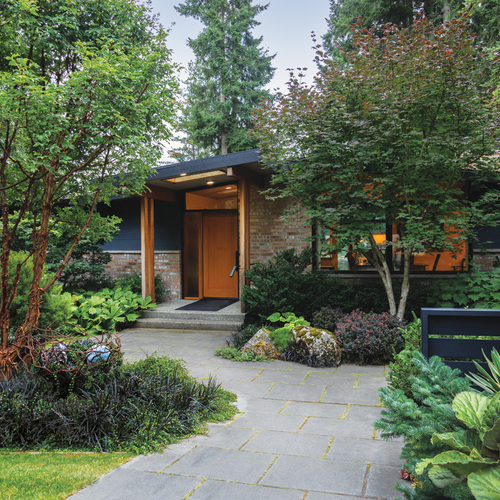Oftentimes what works in life during your 30s and 40s isn’t sustainable later on; this is especially true when it comes to gardening. After more than three decades as a professional gardener with a high-profile, high-maintenance home garden, my husband and I decided it was time for a change of scenery as we neared retirement. Our home and “dream garden” just weren’t the right fit anymore. With a passion for gardening still flourishing and no budget for maintenance service, I needed a home with a low-care garden I could dabble in as I aged.
Our mission: find a turnkey mid-century modern home surrounded by a beautiful garden retreat where we could relax more and work less. We wanted the landscape to attract wildlife and provide year-round food and shelter for bees, birds, and other pollinators. Something with a view I didn’t have to maintain (like mountains or water) would be icing on the cake. In the end, we didn’t get turnkey, but a maintenance-free view of a small lake sold us on a mid-century home that needed both an interior and landscape update.
The existing garden meandered through pockets of sun and shade and was filled with the limited variety of plants you would have found in nurseries in the mid-century, including English ivy (Hedera helix* and cvs., Zones 4–9), azaleas and rhododendrons (Rhododendron spp. and cvs., Zones 4–8), and junipers (Juniperus spp. and cvs., Zones 3–9). With my low-maintenance mission in mind, I revamped the garden and wove the sun and shade areas together by choosing easy-care plants with dynamic textures and calming colors, creating deeply layered beds, and infusing the garden with engaging art.
Choose plants with dynamic textures
Flowers are, of course, a wonderful part of a garden and essential for pollinators, but when it comes to a low-maintenance design with staying power, I pay a lot of attention to foliage. I choose plants with varied leaf sizes, shapes, and surface textures (or sheens). The mix is best with juxtaposed contrasting attributes, such as thin and strappy with large, bold leaves, or hairy matte textures adjacent to smooth, shiny leaf surfaces. Broad groupings and repetition of these features keep the composition from appearing busy and chaotic.
Maximize the Layout, Mask the ViewsWhile the beautiful view of the lake sold the new owners on this house and location, not all sights on the property were pleasing. Plantings were used to screen unwanted views, such as the road from the front window. At the same time, deeply layered beds and borders enhance many of the intimate scenes in each section of the garden. |
|
|
1. House 2. Garage, shop, and greenhouse 3. Front entry path 4. Back deck |
5. Baa (sheep art) 6. Deeply planted fir and rhododendron borders 7. Lake dock |
For my cohesive yet highly textural compositions, I chose from an easy-care, sun- to partial-shade plant palette to bridge the sunny and shady areas. On the downhill side of the house you are first greeted by cold-hardy bananas (Musa basjoo cvs., Zones 5–10) and giant rhubarb (Gunnera manicata, Zones 7–10) as you enter (bottom photo, left). Nestled below these bold leaves is a slower-growing evergreen, dwarf hinoki cypress (Chamaecyparis obtusa ‘Nana Gracilis’, Zones 4–8), which provides a softer texture and year-round structure. The supporting backdrop for these three plants is the deep-blue house and a small, dark-leaved boxleaf azara (Azara microphylla, Zones 8–10).
An adjacent arborvitae (Thuja spp. and cvs., Zones 3–7) repeats the soft texture of the hinoki cypress and provides privacy screening for our upper deck (photo p. 42, top). Skirting the banana and giant rhubarb is ‘Mitsch Select’ Japanese umbrella pine (Sciadopitys verticillata ‘Mitsch Select’, Zones 5–8), a dwarf conifer with whorled needles; ‘Fuchsiade’ hardy fuchsia (Fuchsia ‘Fuchsiade’, Zones 8–10); and multiple Japanese forest grasses (Hakonechloa macra ‘Aureola’, Zones 5–9). This strappy grass adds another texture, and its yellow variegation brightens the composition. A concrete giant rhubarb leaf, which is zero maintenance, provides “evergreen” interest when the banana and live giant rhubarb are down for their winter nap. Evergreen ground cover creeping honeysuckle (Lonicera crassifolia, Zones 7–11) repeats the small green-leaf texture of the boxleaf azara while helping to retain soil moisture.
Create deeply layered beds
When we purchased the property, a good portion of the garden was covered in 12 inches of bone-dry red bark mulch over landscape fabric, which blocked water penetration and the development of organic layers from the soil beneath. It took backbreaking work to remove the obstructive layers and amend the soil, but eventually the plants rewarded us with deeper roots and better drought resistance.
This soil-improvement step dovetailed with the renovation of the planting areas into deeply layered beds to showcase my curated low-care plant palette. Using differing plant heights to create vertical interest, I started by placing my tallest plants first and working my way down. In the entry garden, we first placed a sizable ‘Burgundy Jewel’ maple (Acer circinatum ‘Burgundy Jewel’, Zones 4–9) in front of the dining room window to veil a view of the road (photo pp. 40–41). Because I wanted to evoke the feeling of “hey, you’re home, get ready to relax,” I chose calming colors in shades of green and rich, dark tones. The burgundy of the maple may seem like a departure, but it contributes to the subdued color mix by playing a supporting role with dark contrast that shows off its neighbors.
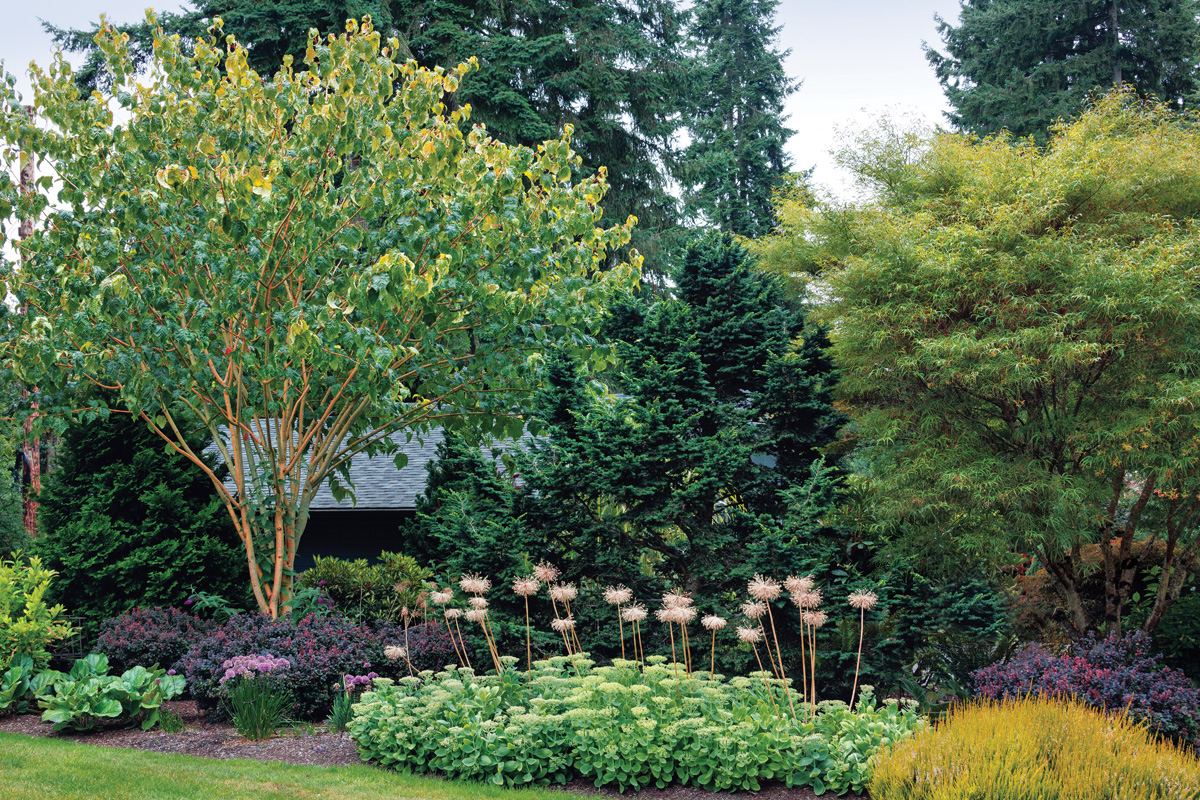
With beds reaching up to 15 feet deep and a rich tapestry of plant layers, the garden complements the scene, serving as a visual partner with the house and hardscapes rather than looking like an afterthought accessory. The fine foliage of English yews (Taxus baccata ‘Amersfoort’ and ‘Melford’, Zones 6–7) and bold palmate leaves of yellow wax bells (Kirengeshoma palmata, Zones 5–8) contribute to the next layer under the canopy of medium-sized star-like leaves of the stunning maple. ‘Concorde’ barberry (Berberis thunbergii* ‘Concorde’, Zones 4–9) adds a grounding color echo of the maple’s burgundy tones, while the large, fuzzy green leaves of ‘Dixter Form’ bergenia (Bergenia ciliata ‘Dixter Form’, Zones 4–8) add a low-growing voluminous contrast. Behind these layers is a hedge of sweet box (Sarcococca confusa, Zones 6–9) chosen for its shade and drought tolerance, late winter flowers that feed the hummingbirds, and medium-sized, glossy deep-green leaves. Its subtle black berries repeat the color of the black mondo grass (Ophiopogon planiscapus and cvs., Zones 6–9) and other dark elements woven through the design in both sun and shade exposures.
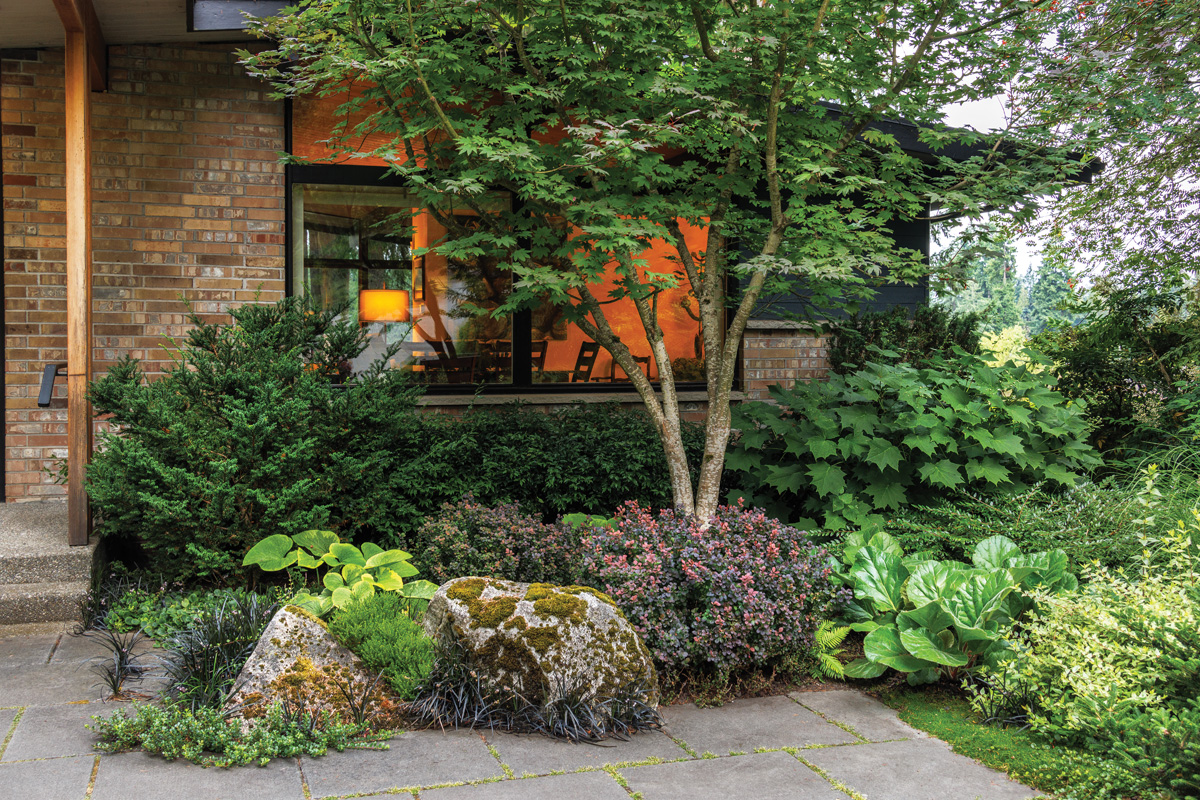
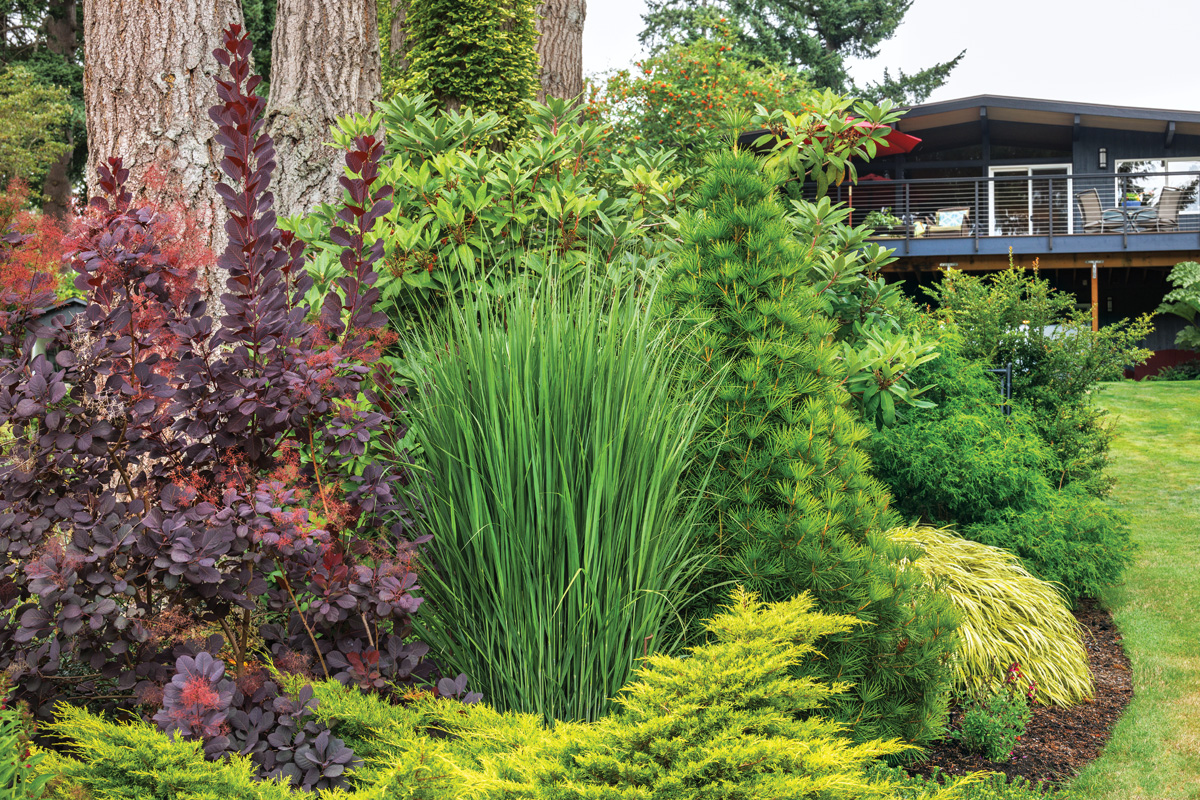
Infuse engaging art throughout the garden
To keep the garden from “disappearing” in the winter months, I like to include a mix of evergreens, plants with architectural and colorful branching structure, rocks, containers, and, especially, art. I find art needs to be incorporated with thoughtful restraint. Too many focal points can confuse the eye, quickly clutter the scene, and diminish their own impact. However, when threaded judiciously throughout the landscape, art is a wonderful tool for visually connecting various parts of a garden and adding year-round interest.
Art is the Jewelry of the Garden that is Best Worn Sparingly
Well-placed art in the garden adds wonderfully surprising moments of whimsy and personality throughout the year. One of the beautiful things about art is that it doesn’t care about sun exposure or water, and it typically requires little to zero maintenance. But there is such a thing as too much. By limiting selections and trickling them throughout each section of the garden it becomes obvious less is indeed more.
I love whimsical art. Pieces I have featured in my garden include an oversized metal nest holding bowling balls as “eggs,” black metal crows on the lawn, a pair of 24-inch-tall concrete periwinkle-blue pears, and a 7-foot-tall metal fork scooping up edible nasturtiums (Tropaeolum majus cvs., annual). I also use rusty forged metal stakes as attractive plant stakes. Finally, Baa, a life-sized concrete sheep, stands in a meadow of unmown lawn and keeps a watchful eye over the lake (photos p. 47). She’s a curiosity to puzzled boaters and is often seen sporting a hat.
Besides the form itself, the color of your art can help tie the scene together by echoing colors of your house, other structures, and plants. The black trim color on my house is repeated in my landscape with black mondo grass, black containers, bowling balls in the metal nest, and the two short metal fence art pieces. The fences were added to define and create a sense of arrival. They are made of powder-coated steel and should never need replacing (bottom right photo).
Placing large containers into the garden as art (planted or not) is a great way to introduce or repeat a color you love or cannot achieve in your plant choices. I like to place them early (after large trees and shrubs are in) then plant around them (photo above).
For me, working with plants is both a labor of love and creative endeavor. I want to make gardens that are manageable and visually pleasing, while still lending support to wildlife, birds, bees, and other pollinators. If I can achieve this collaborative goal without drawing heavily on Earth’s resources, then I think everyone wins, and I rest a bit easier.
Tina Dixon is a horticulture professional with a wealth of plant knowledge and an eye for design in Snohomish, Washington.
Fine Gardening Recommended Products

ARS Telescoping Long Reach Pruner
Fine Gardening receives a commission for items purchased through links on this site, including Amazon Associates and other affiliate advertising programs.
Telescopes from 4 to 7′. Cut and Hold (160) Blades. Drop forged blades for unsurpassed long lasting sharpness. Lightweight, 2.3 lbs., for continued use. Perfectly balanced for easy pruning.
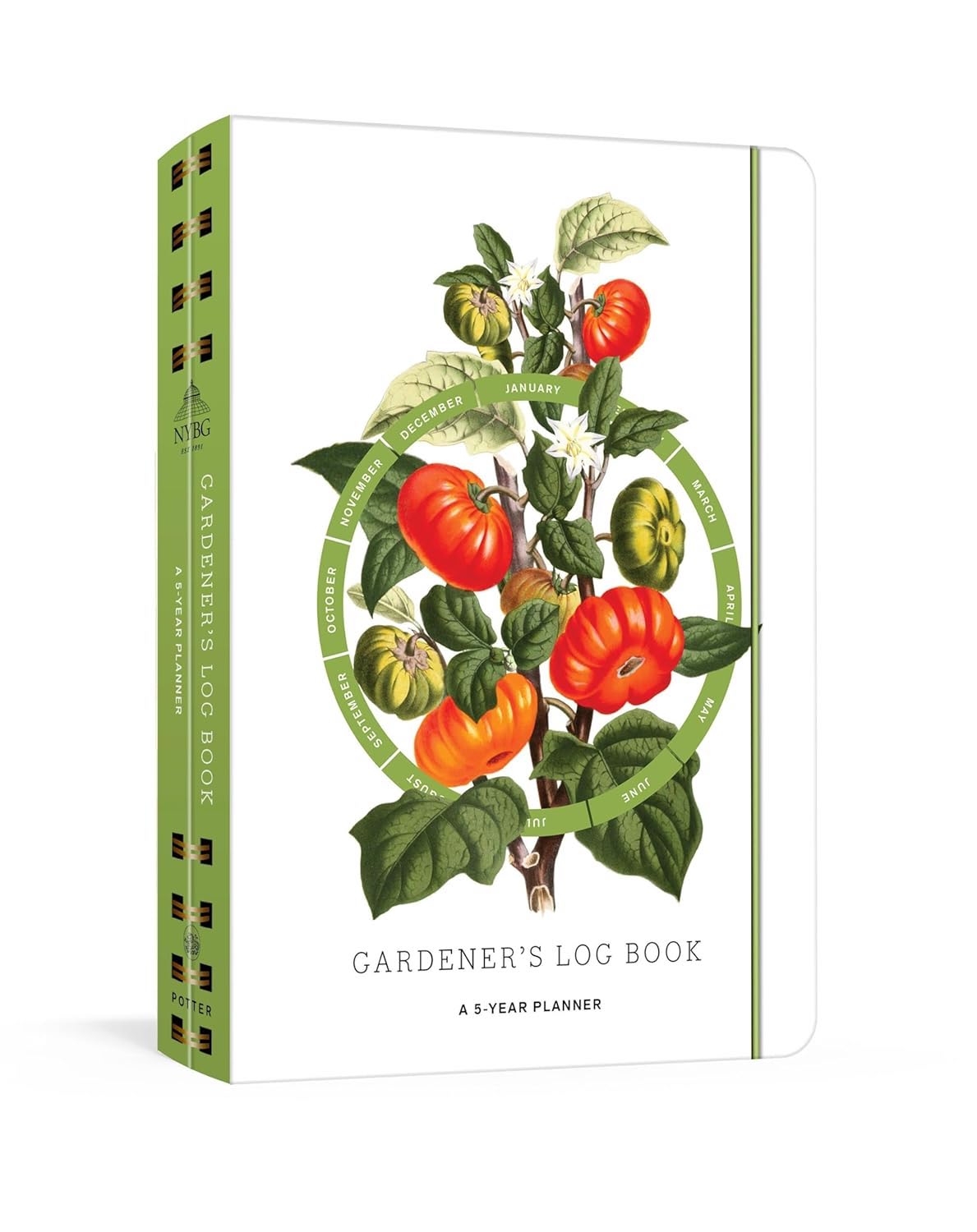
Gardener’s Log Book from NYBG
Fine Gardening receives a commission for items purchased through links on this site, including Amazon Associates and other affiliate advertising programs.
This weatherproof five-year log book includes the following features:
· Sturdy waterproof cover to protect pages from rain and muddy soil
· Lined pages and gridded paper for plotting beds
· Five years of 12-month bloom and harvest grids for recording what you planted and when
· Authoritative appendices on composting, pruning, pest and disease control, and container gardening
· Useful reminders by season on fertilizing, mulching, and transplanting
· Space for listing your favorite sources and suppliers.
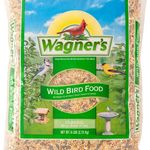
Wagner’s 52003 Classic Blend Wild Bird Food, 6-Pound Bag
Fine Gardening receives a commission for items purchased through links on this site, including Amazon Associates and other affiliate advertising programs.
Classic wild bird food uses the highest quality grains to attract backyard wild Birds. A high-quality mix containing Millet, milo, cracked corn and Sunflower for a wide range of wild birds to enjoy. Perfect for tube, hopper, or platform feeders. Great to feed in all seasons! Perfect for the winter, when seeds are scarce; spring and summer for hatchlings; and autumn to give energy to migrating birds. This seed will help you fill your yard with birds such as Jays, cardinals, doves, Juncos, finches, goosebeaks, any many more.

